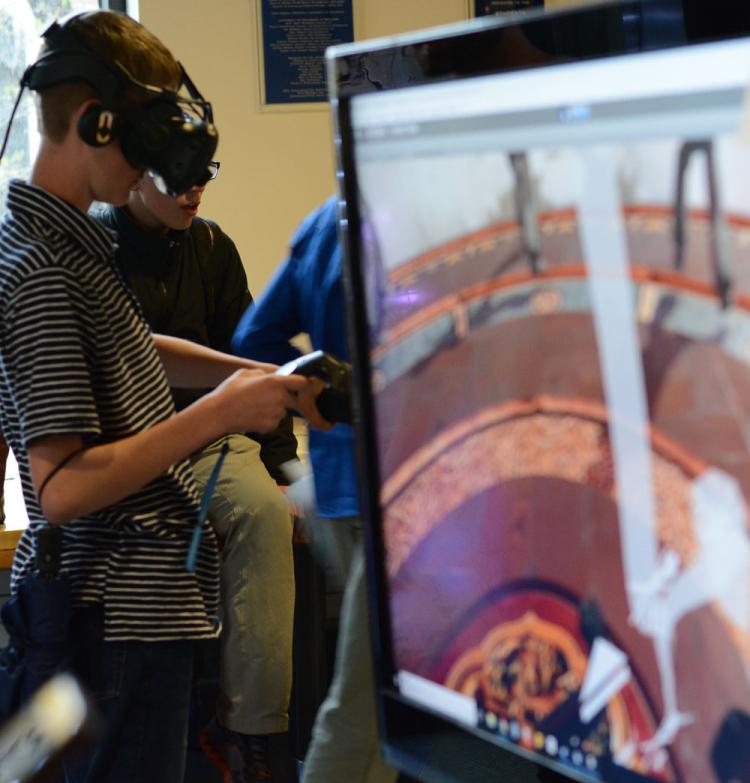ATLAS club an innovation hub for AR/VR community

Justin Chin (left) helps present Cade Haley's app, Tai Chi VR, at ATLAS Expo Spring 2018.
In less than a year, the ATLAS Virtual Reality/Augmented Reality Club swelled to approximately 80 members, including graduate and undergraduate CU Boulder students, high school students and local developers and designers who test, build and collaborate on projects, says club organizer and computer science graduate student Justin Chin.
“Members are excited about the community and sharing their knowledge with others who are interested,” says Chin, who graduates this summer. “If you want to be a pioneer in this industry, there’s no better time than now to join in."
Winning national AR/VR hackathon
A popular project on display at ATLAS Expo Spring 2018 was Tai Chi VR, a virtual reality app for learning tai chi. The work of two members of the AR/VR Club as well as a California-based animator, the app won University of Southern California’s Creating Reality Hackathon earlier this spring, with club members Cade Haley and Roldan Melcon, as well as animator John Yoon, sharing the $5,000 grand prize.
Haley, a CU Boulder computer science and film production major who graduated in May, says that tai chi involves frequent shifts in direction, making it difficult for novices to watch and copy an instructor’s movements. Their VR application solves this problem by surrounding the student with eight animated instructors—no matter which direction the student looks, an instructor is plainly visible. The app also delivers soothing music to the student, who stands on a circular platform floating in the sky surrounded by clouds.
Competing against 400 participants who had been selected from 2,000 applicants nationwide, Haley and his team built their app from scratch in just 48 hours. Besides the prize money, the win also landed Haley a job with a tech start-up out of Purdue University, Explore Interactive, which uses augmented reality to support STEM education.
Club organizer and computer science graduate student Justin Chin’s team won second place in the hackathon’s Microsoft Mixed Reality track. Their project, Follow Me, is an AR emergency simulation training app designed to provide office personnel with emergency information, such as locations of exits, tornado shelters, fire extinguishers and first aid stations. Instead of organizing group trainings and fire drills, their app enables companies to program one AR headset that employees check out to complete the simulated training as part of a standard orientation.
AR/VR Club Thrives

An Expo visitor tries out Tai Chi VR.
Under Chin’s leadership, the ATLAS AR/VR Club has provided education and development of AR/VR related technologies and applications, introducing members to new technology platforms, such as Oculus Rift, HTC VIVE, Google Daydream and Microsoft Hololens.
It’s also a valuable bridge between campus and the local AR/VR development community, providing connections to meetups where members test, build and collaborate on projects. Over the course of the year, the club offered tutorials for beginners using Vuforia AR and Unity, inviting speakers from Occipital, Google News Lab, Viget, NIST and Design Workshop to share their knowledge and experience.
“The biggest barrier is learning the tools to build VR—learning Unity, and in some cases learning to program. Beginner workshops allow people to ease into it,” Chin says.
Harrison Bolin, a first-year TAM major, had no previous experience in Unity when he joined the club, but after completing several club-sponsored Unity workshops, he’s built VR apps and now hosts a weekly virtual reality web show for MediumLabs in Boulder.
“I'm in the AR/VR club because I love learning about emerging technologies,” Bolin says. “The club helps me practice my skills and gives me opportunities to talk to people with the same passion for innovation, as well as share VR projects and hear talks from industry leaders.”
Chin also points to the club’s value in connecting members to AR/VR opportunities, such as Bolin’s internship, the USC hackathon and University of Denver’s Global Game Jam, a hackathon focused on game development.
“Quite a few companies—Trimble, NIST, Ball Aerospace and a variety of startup companies are starting to dip their feet into AR and VR,” Chin says.
In addition, AR/VR is now used in architecture and medical fields. Home buyers “walk through” homes before they are built or view existing houses from the comfort of armchairs. The technology is also being used in nursing homes and hospices to keep residents and patients mentally engaged, which in turn supports pain control.
The AR/VR club was organized by Chin and other students after they completed Assistant Professor Dan Szafir’s Introduction to Virtual Reality course in fall 2016.
“When I was a member of the Makers Collective Club, I saw people working on creative and ambitious projects in the ATLAS BTU Lab,” says Chin. “Similar to BTU and the Makers Collective, I wanted to let students and the community know about the capabilities of AR/VR.”
Chin established the club in ATLAS because he thought it would thrive in an eclectic environment; also, the Mixed Reality Lab had opened in fall 2016, with 10 Oculus VR headsets donated by the manufacturer.
ATLAS Director Mark Gross says, “Thanks to Dan Szafir’s class, the AR/VR club and the Mixed Reality Lab, we have established a lively community of students and researchers building virtual worlds for design, art, entertainment, health and more. It’s great to see it take off.”
Chin graduates this summer, but he’s looking forward to seeing how the club progresses in the future.
"AR/VR is kind of a wild west," he says, "Companies are still discovering the capabilities, and it’s open season for people to explore."
Other AR/VR club member projects
Audio Visual Playground
Clean Getaway
Send Only Memories
Crossovr
Information and club membership


